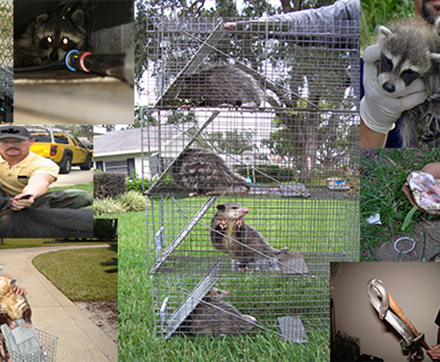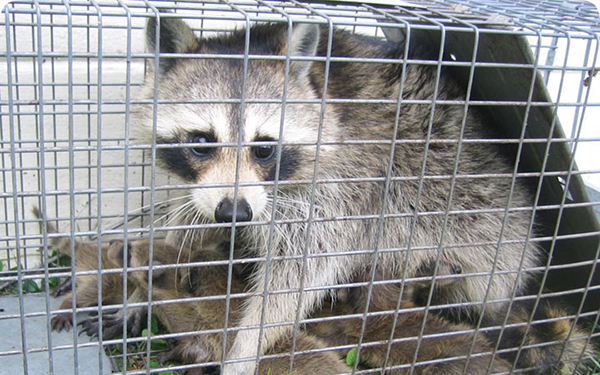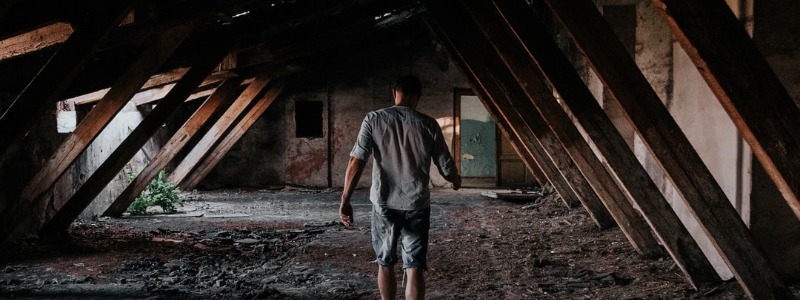Raccoons can be dangerous when cornered, so please do not approach them before calling a professional. Live trapping is not recommended for homeowners when dealing with animals such as raccoons or skunks, which can transmit rabies. Generally, the animal is disposed of; many localities require testing for rabies. Leave this type of trapping to professionals. Homeowners should not attempt to live capture wild animals. If, however, you are prepared to undertake live trapping, then consider these guidelines.
When diagnosing animal damage problems, you should look for signs left by the animal. Almost all animals leave signs — some are more obvious, some are easier to identify, but the sign is usually there somewhere. Droppings are often readily observed, especially for mammals. Fresh droppings are black, shiny, and moist. Old droppings are dry, brown, or gray. Black and white droppings could be from a bird, snake, or lizard. Size is important for identification. Rats, mice, chipmunks, and toads leave droppings the size of a rice grain. Rabbit droppings are pea-size and usually brown. Deer droppings are large ovals and could be deposited loosely or in a large clump, depending on diet. Even in a clump, individual pellets can be easily recognized.
How Does a Raccoon Get in?
You may be wondering why a raccoon chose your house. They will often seek out the attic space as it is a safe place to relax and hides them from the weather. The added security of feeling elevated from the ground reminds them of their natural tree burrow homes. Momma raccoons will also use your attic to have their babies, as infant raccoons face more dangers from predators than adults do. Raccoons have their babies during spring months, meaning that you will likely experience the majority of raccoon activity during this time.

Since raccoons are larger than many animals that get into attics, they will need a larger access point. They have strong, capable hands, and are able to pull down soffit or other materials in order to create their own holes. Most commonly, they will use a roof return – which is where the roof and soffit meet. Often, these roof returns are left open by the original roofers and provide a great entry point for raccoons. Raccoons will typically use one entry point – the main entry point- which can be identified by rub marks on the entry point.

How Do Squirrels Get Into Attics?
Squirrels are extremely agile, as you have probably noticed. They can easily grip and climb all sorts of materials – including the exterior walls of your home. Many squirrels can climb up trees and then jump onto your roof, which makes finding an access point that much easier. All they have to do is squeeze into a hole that is about an inch and a half. They are also able to find smaller holes and chew on the edges to make them large enough to squeeze into.
The most common spot that you will find squirrels gaining access is in your roof returns, the dark corner where the soffit around the home meets the roof. Roofers will leave these open, not thinking about the wildlife that could potentially use it for entry. While it is not nearly as common, they can also gain access through open garage doors, or even under stairs. So, if there is an open spot on your home, a squirrel will more than likely find it and use it to gain access to the home.
Typical Steps in Pest Removal
- Free Inspection:
Step 1 is to call and schedule an estimate. We come out and assess your rodent problem, give you an estimate, and a completion timeline as well. - Humane Trapping:
Next, humanely remove your unwanted rodents or wildlife and quarantine your home of hazardous animal matter. This will ensure the safety of your family. - Repair Entryways:
Step 3 is critical – repair all entryways and add exclusion wire mesh to all structural repairs. This ensures the same colony of critters will not come back to a familiar place. - Reinspection:
revisit your premises to do a re-inspection. quickly spot & respond to signs of critters returning before they’re able to cause major damage again.
Repellants
Repellents are widely used to discourage animal damage. There are many types and some with unbelievable claims of success. Remember the old adage — “If it sounds too good to be true, it is!” Repellents that work with sound waves are generally not effective. Effective repellents work with taste, fear, or odor. Taste repellents render a plant unpalatable to the animal. Fear invoking stimuli are said to elicit an instinctual response such as a deer reacting to predator urine. Odor repellents smell bad to the animal.
Since most animals have a sense of smell hundreds or thousands of times better than our own, even small amounts may prove effective. Some odor repellents may be useless and little more than “urban legends.” Many repellents work in some situations and not others, or work for a time and then lose their effectiveness. Success seems to depend on timing, the density of the animals, the hunger of the animals, and the prior conditioning of the animal. It is better to prevent an animal from browsing your plants than to stop them once they learned to enjoy the taste. Fertilized plants or plants in the early stages of growth are usually damaged more than older, coarse, or sick plants.

